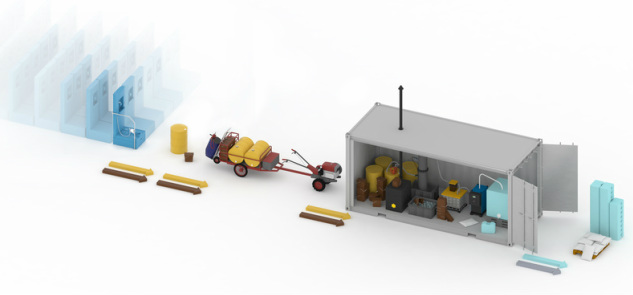Logistic system
The collection and transport of urine and faeces is a labour-intensive process in a complex spatial setup. In order to design an efficient logistic system at moderate costs, we developed a numerical model to evaluate and optimize transport in a variety of spatial set-ups. We used GIS data for the housing structures and road networks of four informal settlements in Africa and India. Regression techniques were used to analyse the spatial data (especially the influence of population density on travel distances). Moreover, bivariate regressions were applied in order to identify the interdependencies of the system parameters, e.g. of service time on costs and capacity. Analysis of the spatial data showed that travel distances are significantly related to user density. However, even at moderate population densities from 100–350 inhabitants per hectare, this has only a minor influence on the system performance. Instead work productivity was identified as the key driver for efficiency. At lower population densities, travel distance plays an increasing role and at very high densities, space will clearly limit the applicability of the concept. This implies that the logistics system is suitable for a range of typical spatial set-ups, but only provided that work productivity is high and space can be found for toilets and treatment facilities. We conclude that one of the most important system integration parameters is the optimization of the process of collecting the faeces containers, pumping urine and discharging it to the RRP, all features strongly influenced by design.
For the business model, an exact number of users per RRP is required to calculate a business case for a given area. We chose Kampala in Uganda, with a user density of 150 inhabitants per hectare and a service time per facility of 20 minutes, resulting in an RRP for 860 users and logistic costs of 1 US cent per user and day. For details please read the following report:
For the business model, an exact number of users per RRP is required to calculate a business case for a given area. We chose Kampala in Uganda, with a user density of 150 inhabitants per hectare and a service time per facility of 20 minutes, resulting in an RRP for 860 users and logistic costs of 1 US cent per user and day. For details please read the following report:
| Logistic-report_Schmitt_2012 | |
| File Size: | 6607 kb |
| File Type: | |


